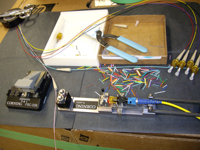

In this area, it is critical that the client have sufficient understanding, as to not overlook an important aspect of the undertaking. What skills are necessary to do this work? What is the scope of the work? What security issues are there? Some electrical contractors claim the ability to install structured cable is based on their ability to “pull wire”. The fact is that today, the media/data type cable, and associated equipment, must support a wide range of technology, most of which requires precise operation. The cable plant installers should not only have experience in installation, but also understand what they are installing, how it works, and how it can be disrupted (i.e. maximum allowable stress on the cable when “pulled”, proximity to lights or other potential sources of interference, maximum allowable cable drop length, etc.). The installers should have the ability to perform tests that ensure the reliable intended operation, and compliance to the related standards.
The installation details should be appropriately documented, typically with as-build drawings, and a post installation certification report for each and every circuit. A good structured cable plant installation would feature some form of warranty on parts & labor.
If a client needs to improve their communication resources, it is best for that client that any particular solution solve not only the specific requirements of today, in a cost effective way, but also allow for the cost effective growth of tomorrow, as compared to only satisfying today’s needs, but perhaps be insufficient & not easily or cost effectively expanded when needed.
Continuously the communications environment becomes more complex as the rate of improvements to computers, and other technologies increases. Often each user needs to share documents, resources and data. Along with the personal computers, and other technologies, numerous departmental computer systems are being installed to solve particular problems at various locations. For optimum benefits, all these components, PC’s, VOIP phones, fax scanning & printing equipment must work together and share information, and perhaps be consolidated. Planning and informed decision-making is the key to success.
The Local Area Network (LAN) / Wide Area Networks (WAN) offer on one hand, many potential solutions, but also bringing with them a new set of questions. LAN’s & WAN’s offer reliable high speed communications channels, optimized for connecting information processing equipment, in a wide geographic area, an office, building, complex of buildings or a campuses around the world.
LAN’s & WAN’s elude precise definition because they can be designed with a rich variety of technologies and topologies (i.e. many types of equipment arranged in many different grouped configurations around the world). Perhaps LAN’s & WAN’s are best defined in terms of the services they provide and the applications they make possible. The communications offered by LAN’s & WAN’s greatly facilitate information exchange, and resource sharing, including: data, voice, video, printing, email, internet access, internet firewall security, etc. They have now become an even more critical component of a typical business or organization, with respect to efficiency, security, connectivity, etc.
The complexity and expense of copper & fiber cable, and other aspects of a communication infrastructure {i.e. RF , IR, satellite, etc.}, can be formidable. In an actively changing environment, without proper planning, rewiring may prove to be disruptive and costly, however, with “Plug & Play” racks, resources can be reconfigured in minutes, without disruption to other users. With more intelligent devices and computers, and despite a well-designed “Network Communication Infrastructure”, bottlenecks will occur. However, they can be predicted, and monitored, especially after a change in resources, or otherwise, to seek optimum performance and reliability.
As the volume of electronic information transferred within an organization increases, the value of proper planning becomes increasingly paramount to the effective, reliable, and efficient use of any communications network and infrastructure. Methodical planning, with appropriate detail, making realistic accommodations for future growth, helps to alleviate the high costs associated with last minute planning, and “as required” changes.
Any relationship between Len Andrews Enterprises Inc. and our client, will typically involve a high degree of integration and cooperation of team members, comprised from your organization and ours. We embark on a process of engaging with the client, to get to know them, and the nature of their business, and develop an understanding of their particular needs. It is ONLY when you have ascertained the precise definition of the client’s needs, can you be in a position to devise a solution for those specific needs, and define with appropriate precision.
Consulting may be described as; the act of participating in a process, assisting the client, as needs cannot be cost effectively or fully provided from within. In other words, fulfilling the client’s seeking of knowledge, and assistance, in an area that they do not have sufficient, cost effective, expertise within the client’s organization or business.
Sometimes, our consulting role can be as simple as providing feedback with respect to a client’s own plan. Other times, we take responsibility for much, and at times all, of the aspects of the undertaking. This all depends on the particular client’s requirements. Implementing resultant recommendations must be done so by utilizing, to the optimum extent, internal resources, therefore reducing need for external resources, hence likely lower costs. This is all orchestrated with the over riding notion that the integrity of the undertaking not be compromised in any aspect (i.e. cost effectiveness, reliability, longevity, security, etc.). The difference between a “good job” and a “bad job” is the attention afforded to procedure, detail of undertaking, as well as to final testing/certification of EVERY circuit and device comprising the system. Also, only quality components will provide a system that possesses a high degree of reliability, and longevity.

